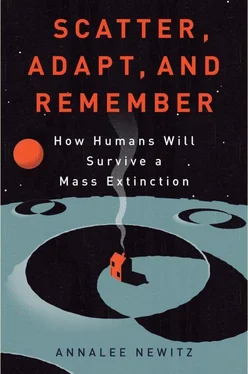It could be that one small group of H. sapiens developed a genetic mutation that led to experiments with cultural expression. Then, the capacity to do it spread via mating between groups because storytelling and symbolic thought were invaluable survival skills for a species that regularly encountered unfamiliar environments. Using language and stories, one group could explain to another how to hunt the local animals and which plants were safe to eat. Armed with this information, humans could conquer territory more quickly. Any group that could do this would have a higher chance of surviving relocation time and again. The more those groups survived, the more able they were to pass along any genetic predisposition for symbolic communication.
Perhaps H. sapiens ’ knack for symbolic culture was also a result of sexual selection, in which certain genes spread because their bearers are more attractive to the opposite sex. Put simply, these attractive people get laid more often, and therefore have more chances to spread their genes to the next generation. In his book The Mating Mind, evolutionary psychologist Geoffrey Miller argues that among ancient humans, the most attractive people were good with language and tools. The result would be a population in which sexual selection created successively more symbol-oriented people. Two anthropologists, Gregory Cochran and Henry Harpending, amplify this point. They argue that some of the genes that spread like wildfire through the human population over the past 50,000 years are associated with cranial capacity—brain size—and language ability. “Life is a breeding experiment,” Cochran and Harpending write in their book The 10,000 Year Explosion .
Our capacity for symbolism evolved quickly, partly because our mating choices would have been shaped by our needs as creatures who evolved to survive by founding new communities. Over the past million years, humans bred themselves to be the ultimate survivors, capable of both exploring the world and adapting to it by sharing stories about what we found there.
How Can We Possibly Know All This?
A lot of the evidence we have for the routes that humans took out of Africa comes from objects and places you can see with your own eyes. Paleontologists have found our ancestors’ ancient bones, as well as their tools. To figure out the ages of these tools and skeletons, we use the same kinds of dating techniques that geologists use to discover the history of rocks. In fact, when an anthropologist talks about “dating the age of fossils,” he or she isn’t actually talking about the bones themselves—to date old bones, anthropologists carefully excavate them and take samples of the rock surrounding them. Then they pin a date on those rocks, under the assumption that the bones come from roughly the same era as the rocks or sand that covered them up. Basically, we date fossils by association, which is why you’ll often hear scientists suggesting that a particular fossil might be between 100,000 and 80,000 years old. Though we can’t pin an exact month or year on each fossil discovery, we do have ample evidence that certain humans like H. ergaster came before other humans like H. erectus in evolutionary and geological time.
Over the past decade, however, the study of ancient bones has been revolutionized by new technologies for sequencing genomes, including DNA extracted from the fossils of Neanderthals and other hominins who lived in the past 50,000 years (sadly, we don’t have the ability to sequence DNA from Australopithecus or H. ergaster bones—their DNA is too decayed). At the Max Planck Institute in Leipzig, Germany, an evolutionary geneticist named Svante Pääbo and his team have developed technology to extract nearly intact genomes from Neanderthal bones. First they grind the bones to dust and chemically amplify whatever DNA molecules they can find, then analyze this genetic material using the same kinds of sequencers that decode the DNA of living creatures today. We’ll deal with the Neanderthal genome more in the next chapter, but suffice it to say that we have pretty solid evidence about the genetic relationships between H. sapiens and its sibling species H. neanderthalensis .
A lot of the evidence for humans’ low genetic diversity has been made possible by DNA-reading technologies developed since the first human genome was sequenced, in the early 1990s. Though that first human genome took over a decade to sequence, we now have machines capable of reading the entire set of letters making up one genome in just a few hours. As a result, population geneticists are accumulating a diverse sampling of sequenced human genomes, from people all over the world. Many of these genomes are collected into data sets that scientists can feed into software that does everything from make very simple comparisons between two genomes (literally analyzing the similarities and differences between one long string of letters and another), to extremely complex simulations of how these genomes might have evolved over time.
One of the first pieces of genetic evidence for the serial-founder theory emerged when scientists had collected DNA sequences from enough people that we could start to analyze genetic diversity in different regions all over the world. Geneticists discovered a telltale pattern: People born in Africa and India tend to have much greater genetic diversity than people born elsewhere. This is precisely the kind of pattern you’d expect to see in a world population that grew out of founder groups originating in Africa. Remember, each successive founder group has less and less genetic diversity. So people descended from groups that stayed in Africa or India are from early founder groups. People in Europe, Australia, Asia, and the Americas were the result of hundreds of generations of founder effects—so we’d expect them to have less genetic diversity. When you add this genetic evidence to the physical evidence from fossils and tools left behind by people leaving Africa, you wind up with a fairly solid theory that founder effects created our genetic bottleneck.
An Eruption That Launched Humanity
Though it’s likely that the genetic bottlenecks we observe in the human population were caused mostly by founder effects and sexual selection, there is some evidence that the final human radiation out of Africa was precipitated by a catastrophe. Ancient humans had been crossing the Sinai out of Africa and into the rest of the world for over a million years, but roughly 80,000 years ago there was an extremely large migration that changed the world and every human on it. H. sapiens, a human with language, clothing, and sophisticated tools, took over Africa, then migrated beyond its borders. Certainly it’s possible that this wave of human immigrants was spurred by mass deaths in the wake of the Toba eruption. But that’s debatable.
What’s certain is another explosion that nobody denies: the one in human symbolic communication. Our capacity for culture is what allowed us to survive in the perilous lands beyond the warm, fecund West African regions where Australopithecus first stood up. We never stayed in any one place for long. We moved into new places, founding new communities. And when we evolved complex symbolic intelligence, our growing facility with tools and language made these migrations easier. We could take advantage of many kinds of environments, teaching each other about their bounties and dangers in advance.
As H. sapiens poured off the continent of our birth, we discovered lands inhabited by our sibling hominins. We had to adapt to a world that already had humans in it. What came next will take us into one of the most controversial areas of population genetics and human evolutionary history.
Читать дальше






![Аннали Ньюиц - Автономность [litres]](/books/424681/annali-nyuic-avtonomnost-litres-thumb.webp)





